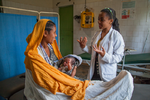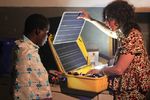Click here to register!
Access to modern energy and the impact on health
Overview
Despite rather limited access to data, it is clear that the lack of access to energy dramatically affects and undermines people’s health. The situation is alarming, especially in sub-Saharan Africa, the continent facing the biggest task in meeting the UN SDG7 by 2030 while simultaneously facing the biggest worldwide population increase in the same period.
A study by Adair-Rohani on a significant sample of health care facilities in 11 countries in sub-Saharan Africa, found that on average 26% of health facilities reported no access to electricity. Only 28% of health care facilities, on average, had reliable electricity among the 8 countries reporting data. This leaves the majority with partial and unreliable access to electricity.[1] Unreliable electricity supplies result in a loss of almost half of the vaccine supplies as well as the failing of 70% of the electrical medical equipment used in developing countries.[2]
Furthermore, according to the World Health Organisation (WHO), around 3 billion people worldwide rely on open fires or simple stoves fuelled by traditional biomass (wood, charcoal, animal dung). As a consequence of inadequate ventilation, people breathe substances that are very harmful to their health, resulting in 3.8 million dying prematurely from illnesses attributable to Household Air Pollution (HAP), and is also the cause of half of deaths due to pneumonia of under 5 years of age.[3]
The International Energy Agency estimates that if governments do not take strong action the problem will persist and worsen over time. In sub-Saharan Africa, over 300 million people are expected to gain access to clean cooking facilities by 2030, yet progress is not sufficient to keep pace with population growth. Therefore, the number of people relying on biomass is expected to grow from 780 million in 2015 to 820 million in 2030, 56% of the population.[2]
Health and access to electricity in hospitals and clinics
Where hospitals and health-clinics do not have access to reliable electricity, patients cannot get optimal care, as many life-saving interventions are not accessible. Standard operating procedures for most hospitals require energy use for water and temperature control, lighting, ventilation, and clinical processes. Unreliable electricity access therefore leads to vaccine spoilage, interruptions in the use of essential medical and diagnostic devices, and lack of even the most basic lighting and communication for childbirth and emergency procedures. As disease patterns change, even more energy is required to expand services for prevention and treatment of non-communicable diseases (NCDs). These include the diagnosis and treatment of breast cancer, cervical cancer, and other NCDs where women carry a particularly heavy burden.
The quality of energy access in health facilities also has far-reaching impacts on other aspects of health services. These may include the hours of operation, retention of health workers as well as the burden of proving food for the patients and staff.
Hospitals and clinics located near an electricity grid connection have traditionally relied on grid power as a primary energy source. Yet power failures or outages during periods of peak demand are a problem even in grid-connected cities and regions. This forces clinics to rely on expensive backup generators – or to remain without power.
In off-grid settings, stand-alone diesel-powered generators have been the most common solution, backed up mostly by kerosene lamps, candles or flashlights. Generators, however, are expensive to operate due to the increasingly high cost of fuel combined with the need to transport and store them as well as the necessity for regular maintenance for optimal use. As the cost of renewable energy technologies have fallen over the past years, they have become more affordable for health facilities. This is particularly true in the case of photovoltaic (PV) solar power and explains the recent trend towards increasing use of onsite PV solar, as both a primary or backup electricity source.[4]
Furthermore, the emergence of more energy-efficient medical devices that operate on low-power battery and solar panel sources creates new opportunities to improve energy access using demand-side measures.[4] PV solar-powered refrigerators are increasingly being used for more robust cold-chain preservation. In countries with plenty of sunlight, larger PV arrays with batteries, used alone or in tandem with a fuel-based generator, can efficiently power a range of low and medium-power devices, including small laboratory devices, water pumps, lights, phones and small medical devices.
Access to modern energy and energy efficient medical devices has significant health effects when made available in health facilities. To get an overview of the options for the improvement of the energy situation in rural health facilities, please view the Energy for Rural Health Centers article on energypedia.
Health and Household Air Pollution
Where households or villages do not have access to modern energy they:
- Depend on the collection of firewood, which leads to musculoskeletal damage, consumes considerable time, limits income generation activities, and limits education for children. In less secure environments, women and children furthermore face the risk of injury and violent attacks when collecting the wood.
- Depend on the burning of certain fuels and the use of old technologies that expose them to a range of pollutants, such as black carbon and kerosene which have deadly long-term consequences, especially for women and children.
- Are exposed to the risk of burns and injury as well as accidental fires caused by the open fires.
According to the WHO, more than 40% of the world’s population still depend on polluting fuels, including biomass fuels (wood, dung, agricultural residues), kerosene and coal, for their energy needs. Cooking, heating and lighting with polluting fuels on open fires or traditional stoves results in high levels of Household Air Pollution (HAP). Indoor smoke contains a range of health-damaging pollutants, such as small particles and carbon monoxide that penetrate into the lungs and blood-stream causing severe long-term effects on health. Women and children spend an average of 3-7 hours cooking over open fires every day, and are therefore more likely to suffer the negative consequences of HAP. Young children are especially sensitive to such particles as their lungs are immature and their immune system is developing. There is, according to the WHO, consistent evidence that exposure to HAP can lead to acute lower respiratory infections in children under five, and heart disease, stroke, chronic obstructive pulmonary disease and lung cancer in adults. In 2016, household air pollution was responsible for 7.7% of the global mortality.[5]
Efforts to improve household access to electricity and clean cooking and heating goes a long way to address these problems. Simple Pico PV systems and stand-alone solar home systems can be an efficient way of providing a first-time access to households at a minimal cost, and there are many different “modern” cooking stoves available on the market today, some more efficient than others. The benefits of adopting these modern systems are multiple, they have significant positive health effects as well as significantly improve the lives of women and children particularly.
Read more about Indoor Air Pollution Measurement.
Further information can be found on Pico PV systems and solar home systems as part of the Solar Portal on Energypedia. Furthermore, a full overview on Clean Cooking possibilities, challenges and solutions can be found on the Improved Cooking portal.
Conclusion
It is clear that more emphasis must be given to stress the health benefits that are linked to providing access to clean and modern energy for all. Synergies between energy access, local and household air pollution, health trends and climate change must translate into integrated policies and local initiatives. In order to do this, it is essential to improve the collection of reliable data, which will allow for the monitoring of trends and identifying gaps. Increased geographical reporting is needed to build a global understanding of the situation and to identify the segments of the population greatest in need. Some form of standardization in the collection of such data and identification of some measurable indicators would be useful for comparing assessments and would require cooperation among international agencies and national ministries. With more comprehensive and standardized tracking systems, countries will be able to monitor progress toward powering health facilities and the impacts on health and development, forecast future energy needs, better allocate limited resources, and share experiences with new and innovative energy solutions.[6]
Increased education and awareness about the importance of using clean modern energy is fundamental for overall success, especially among the most vulnerable segments of societies. Modern energy systems must meet certain quality standards that protect the consumer and makes the investment worthwhile both from a financial and health perspective. Products must meet the specific local cooking practices of the local population and business plans must meet the financial capabilities of the population.
Further Information
- Other articles on Health Impacts of Energy Access
- Energy for Rural Health Centers
- Energy for Rural Health Centers
- GIZ HERA: Energy for Rural Health Centers
- Access to Modern Energy#Health
References
- Limited electricity access in health facilities of sub-Saharan Africa: A systematic review of data on electricity access, sources and reliability, Adair-Rohani et al, Global Health: Science and Practice, Vol 1, Number 2, 2013
- Access to Modern Energy Services for Health Facilities in Resource-Constrained Settings - A Review of Status, Significance, Challenges and Measurement, WHO, 2014
- WEO-2017 Special Report: Energy Access Outlook, International Energy Agency, 2017
- World health report, World Health Organisation, 2013
- Ambient air pollution: A global assessment of exposure and burden of disease, World Health Organisation, 2016
- ↑ Adair-Rohani and Al, Limited electricity access in health facilities of sub-Saharan Africa: a systematic review of data on electricity access, sources, and reliability, Global Health: Science and Practice, August 2013, 1(2):249-261; https://doi.org/10.9745/GHSP-D-13-00037
- ↑ 2.0 2.1 WEO-2017 Special Report: Energy Access Outlook, International Energy Agency, 2017, p.29 Cite error: Invalid
<ref>tag; name "WEO-2017 Special Report: Energy Access Outlook, International Energy Agency, 2017." defined multiple times with different content - ↑ WHO: http://www.who.int/news-room/fact-sheets/detail/household-air-pollution-and-health
- ↑ 4.0 4.1 Access to Modern Energy Services for Health Facilities in Resource-Constrained Settings - A Review of Status, Significance, Challenges and Measurement, WHO, 2014
- ↑ http://www.who.int/gho/phe/indoor_air_pollution/en/
- ↑ Adair-Rohani et al, Limited electricity access in health facilities of sub-Saharan Africa: a systematic review of data on electricity access, sources, and reliability, Global Health: Science and Practice, August 2013, 1(2):249-261; https://doi.org/10.9745/GHSP-D-13-00037
|
This article is part of the Energy Access Portal which is a joint collaboration between energypedia UG and the “World Access to Modern Energy (WAME)". WAME is managed by the Museo Nazionale della Scienza e Tecnologia Leonardo da Vinci (MuST), the Fondazione AEM and the Florence School of Regulation (FSR) and it is supported by Fondazione CARIPLO. |
Written by: Pia Lovengreen Alessi, Florence School of Regulation and World Access to Modern Energy.

























